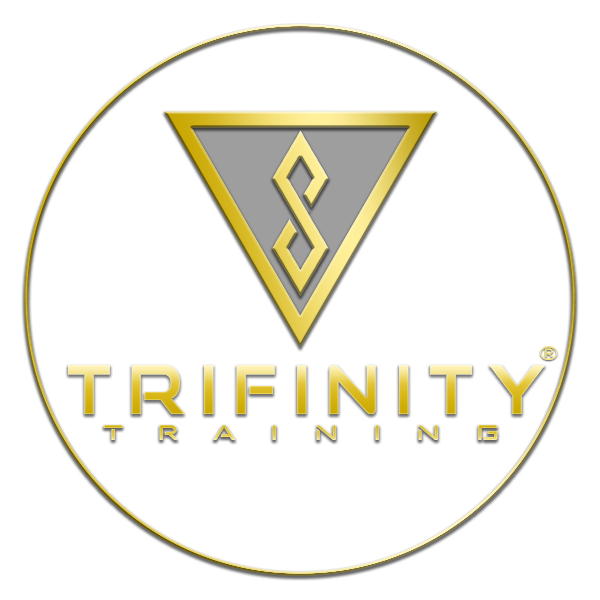Build Big Arms – Part 1: Biceps
You want to build bigger arms – you do your biceps curls with barbells, alternating dumbbell curls and all that you know you should do to activate them. You train them once a week, maybe two or more? 2 sets, 3 sets … 5 sets per exercise? High repetitions or maybe low? You kill it day in and day out and do everything you can to build yourself a pair of impressive and huge arms. You put down “blood, sweat and tears” but notice, nonetheless, that your arms are not developing at the pace you might want? You are not alone – whether you want to build bigger arms or you do not get the results you want. There are others out there searching – believe me … I know.
“I want to build bigger arms”
had I received a penny every time I heard it…
Yes, sometimes the hunger, for big and well-trained arms, has sometimes felt as the clichéd expression above says: “had I received a penny every time I heard it …”. I just need to flip back in some questionnaires and updates submitted by my clients in recent days to find someone with the goal: “would like to build bigger arms“. In the past, it was the majority of guys who wanted to put extra focus on the development of the arms, but there are actually more and more girls who have such goals as well – in addition to “legs and booty”, which tops high among the girls’ focus and priority now.
“There’s no accounting for taste”. Yes, haha, I love how everyone is different with different goals with their training and what they specifically want to put extra focus on. I mean not only by developing more muscle mass but also when it comes to the development of strength, speed, endurance, explosiveness and more. However, it is always important to think about the whole and not just work in the areas you want and feel comfortable doing. You know those who are on fire when it’s upper body training but feel “under the weather” when it’s time to train their legs? Finding and creating balance from top to toe, back to front and left to right is so important. Having all the parts in the chain of muscles that work with each other, or against each other as agonists – antagonists do, is extremely important for optimal development and not to mention minimizing the risk of injury.
To quickly explain agonists and antagonists so you do not have to leave to think about it. We take arms as an example and look at a movement where we extend the arm (extension in the elbow joint). The triceps do most of the work and contract. The triceps then acts as an agonist in the movement. The biceps are stretched and act as an antagonist in the movement. On the contrary, if we were to bend the elbow (flexion of the elbow joint) and tense the biceps, the biceps would act as an agonist and the triceps as an antagonist. The biceps and triceps can thus be both antagonists and agonists depending on whether we perform a stretch or bend in the elbow joint. Awesome, now you know! We continue with the arm building.
Biceps - anatomy, structure and function
Before we dive into different exercises, angles, techniques and training volume, I want us to go through the anatomy, structure and function of the biceps. It is important that you know the basics here before we move on. I will not be long-winded and talk about “tuberculum supraglenoidale” or “processus coracoideus” – which for many certainly sounds like alien language. I know you’re in a hurry to get to the gym and try out some new techniques. This is also where I want the information in this post to take you. We go through “the basics” that you need.
* Tuberculum supraglenoidale and processus coracoideus are the origin (read: attachments) of the biceps brachii.
So, let me introduce the biceps brachii, the two headed arm muscle. For those of you who do not know, you will find it on the front of the upper arm. It’s the muscle that’s a little tense right now when you hold your coffee cup in front of you.

The picture above is the arm seen from the front and the different parts of the biceps. As I wrote above, we go through the basics and what we focus on now are parts 1-3.
1. Biceps Brachii – short head
2. Biceps Brachii – long head
3. Brachialis
The third, the brachialis, does not belong to the “biceps brachii” but is a muscle that lies just below and slightly under the biceps. Why I add it is partly because you do not know that there is even a small muscle underneath here and partly because it actually matters when it comes to the development of your arms. The biceps short head goes inside, towards the body, off the upper arm and the biceps long head goes more towards the outside.
What many also do not know is that the biceps is a two-joint muscle and goes over the elbow joint and the shoulder joint. This is something that many do not think about and why I want to take the opportunity to address this is because I have worked with clients who came to me with pain in the shoulder that turned out to be an inflammation of the biceps brachiis long head. The long head of the biceps brachii attaches to the front of the shoulder and an inflammation here can often be mistaken as a problem in the shoulder. Inflammation in the origin (attachment) of the long head can, however, lead to it spreading further to the joints and muscles of the shoulder. Vice versa, an inflammation in the shoulder can also lead to an inflammation in the biceps long head attachment.
The function of the biceps is flexion (bending movement / “contracting”) in both the shoulder and elbow joints. In addition, the muscle performs a supination (outward rotation) of the forearm.
How to activate the different parts (muscle heads)
You may not have put any extra weight on it and always thought that a biceps exercise is training the biceps, period. If you do a flexion in the elbow joint, you will activate the biceps and I completely agree with that. But which part of the two heads, short (1) or long (2), you activate more is what is interesting here and it all depends on the supination (rotation) of the forearm. The grip and angle of your forearm, during the movement, actually has a big impact on which of these two parts (heads) of the biceps you activate more. Brachialis (3) is also activated more in one separate grip than in the other and we will also go more into that now.
1. Supinated grip
Supinated grip is usually described as a grip where you have the palms facing the body. I have noticed that several clients are starting to think about this when it comes to performing biceps curls. A supine grip in biceps curls is in the bottom position with the palms facing away from the body and this is the supine grip for biceps curls. You will notice, unless you have some really crazy rotational ability in your wrists (speaking of alien), that you will in the top position have your palms facing you. The example is often used with the exercise chin ups, with a supinated grip, where you pull yourself up with your palms facing towards you.
Below you see biceps curls with a straight bar and with a supinated grip.

“Which part (muscle head) activates biceps curls with a supinated grip?”
A supinated grip in the biceps curls activates more the shorter head (1) of the Biceps brachii.
2. Pronated grip
Pronated grip is then the opposite of a supinated grip. You keep your palms facing away from your body. Again, it is needed to explain the pronated grip when it comes to biceps curls. You keep your palms facing your body in the bottom position but this is the prone grip for biceps curls. Prone grip in pull ups is when you pull yourself up with the palms facing away from your body.
Below you see biceps curls with a straight bar and with a pronated grip.
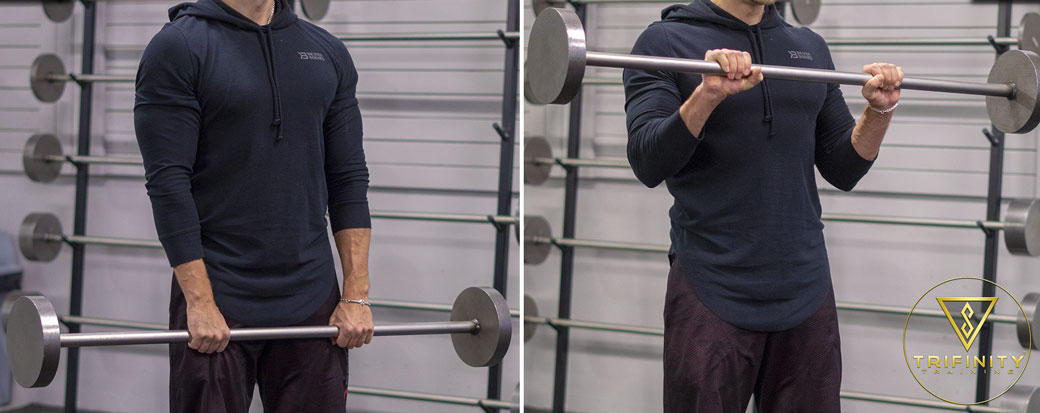
“Which part (muscle head) activates biceps curls with a pronated grip?”
A pronated grip in the biceps curls activates more the long head (2) of the Biceps brachii. The pronated grip also activates more brachialis and the forearm (brachioradialis).
3. Semi-supinated grip / "hammer"-grip
The semi-supinated grip or the more common name “hammer” grip is more common in the gym than the pronated grip. At least when it comes to biceps exercises. This is when you hold your hand angled with your thumb up (if the exercise is done standing up) and your palms facing each other. As the description “hammer” grip says, you can imagine the grip that you hold a hammer with.
Below you see biceps cable curls with rope and with a semi-supinated grip.
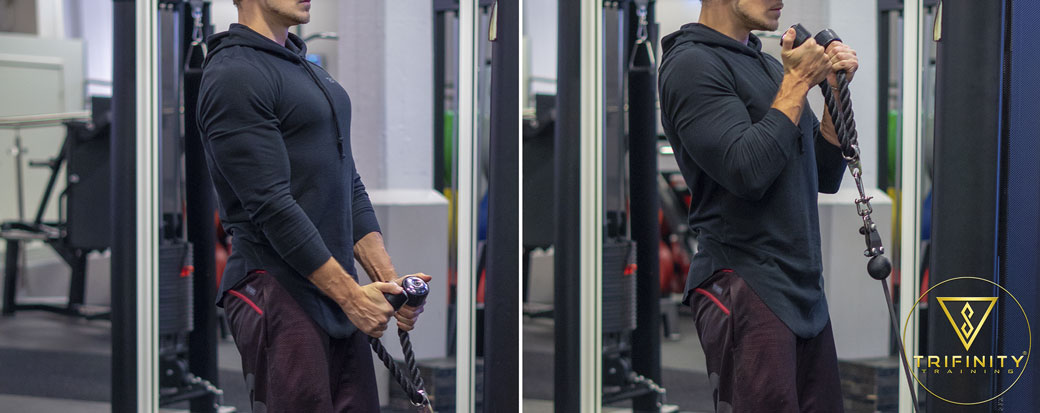
“Which part (muscle head) activates biceps curls with a semi-supinated grip?”
A semi-supinated grip in the biceps curls also activates the long head (2) of the biceps brachii more. The semi-supinated grip also activates more brachialis and the forearm (brachioradialis).
Training volume - How many sets and reps?
When it comes to how many sets and reps you should perform for the biceps, we must start by seeing how experienced you are when it comes to strength training. What many beginners do wrong is that they look for the most brutal training program they can find online where the training volume is far too high and the risk is that it only in the end does more harm than good. If you are a beginner and take your first steps on the gym floor, around 8-10 sets is more than enough for biceps a week. If you have a couple of years “on your neck” and your muscles are used to the load that is put on them from strength training, you can easily go up to 16+ sets a week and this preferably divided into two different training sessions.
If we talk about how many reps you should perform per set, there are two things to review:
1. The execution (technique) in the exercises with a certain weight.
2. What are you looking for? Strength or size?
We have all seen them, they throw around 40kg dumbbells in dumbbell curls, scream so the roof lifts and get, in one way or another, some reps. Sometimes I wonder if the legs, when they both take charge and dive under the weight during the “swing”, get more activation or if the lumbar spine does it when they lean backwards to continue the swinging moment they started with the legs. In the end, we can see that in any case there are not many biceps fibers they activate here. We can also completely forget about the eccentric phase (down), as all the tension in that phase is often released completely. When you train the biceps, you should feel it in the biceps and you create that with full contact and full range of motion in the exercise.
Also think about what your goal is with your biceps curls. Is it to train to get stronger or to get bigger? Combining these two points, 1. correct execution and 2. what is your goal, gives us a guideline on which reps interval exactly you should try to stay within. For strength there is a guideline to stay around 1-6 repetitions and for hypertrophy (muscle growth) anything between 8-15 +. Checking out point 1, correct execution, and being under 4-6 reps for different biceps curls has, from experience, been seen as difficult. There is simply too much swinging and jumping, especially among the more inexperienced clients. More experienced strength trainers can be seen to do better as the whole “package” (body) from top to toe can balance and stabilize the lift / curls better. But even here you often see a very unnecessary movement in the body. If you are looking for size (hypertrophy), I would like you to stay between 8-15 repetitions. With these higher number of reps, you will be able to squeeze out the biceps more easily and really feel the muscle you are working out.
Variation is the key.
Regardless of whether you are looking for pure and raw strength or size, you benefit from varying your number of reps. If you have been doing your low reps for a long time, try doing a little higher. If, on the contrary, you have been doing a higher number of reps, try to take a little heavier weights and lower the reps. However, do not let heavier weights take over the correct and good execution in the exercises. I think a normal “swing” in the body is absolutely in order. You should not have to tense up as if you had something up in… well… yes you know where. I do not consider that to be the correct execution either. Learn to activate your biceps with a normal flow in the body, without swinging too much or with excessive backward tilt.
The variation can be done by performing all the exercises within a certain reps interval for a few weeks and then switching to another. From low reps to high or vice versa. You can also keep a variation during one and the same workout. One exercise you do heavier, for example at the beginning of the workout when you have the most energy, with lower reps and others you can aim for higher and more squeezing out and isolating the muscle.
It’s more about what you do and how you do it.
Giving tips on the number of sets and reps is much more about reviewing what you do and how you do it than just saying “do this and that many sets and reps”. We have gone through different parts of the biceps now and you understand how different grips activate different parts of the arm muscle. We will use this theory in practice. I have had clients who I have seen have had sufficient volume in their arm training, but when you start to look more closely at where that volume is placed, it has been 90% on the inner head (1). The exercises have largely only consisted of exercises with a supinated grip.
It is also about reviewing how the client trains once they train. This is very important as a Coach and PT to learn to see or find out about their client. If you week out and week in do your 3 sets with 10 reps in barbell curls with 30kg on the bar, your biceps will eventually stop growing bigger and stronger. Why would the muscle need to grow bigger and become stronger if it does not need to lift more or perform any other type of technique? It simply becomes “comfortable” with being the size it is because it is not loaded with more. If, on the other hand, you increase in weights but you give in to the correct execution in the exercise to be able to lift that bigger weight with good form, the load and stimulus for the biceps, during the execution, will be lost. Finding the balance between training hard and heavy with a correct and good execution in the exercises is a must for optimal growth.
There are those who do too much and there are those who do too little. You must dare to step out of the comfort zone and take a little heavier weights or lift more repetitions with the same weight to send signals to the muscle that it needs to grow stronger and bigger. Train hard – but smart.
The theory in practice - activate the different parts
Optimal training and development of your biceps is about activating the different parts of the arm muscle and stimulating them to grow. You should now, if you have learned something from what I have written so far, understand how we activate the different parts and understand what applies when it comes to training volume.
So how do we set up a bicep workout?
Make sure you get the two muscle heads, short (1) and long (2), stimulated and also brachialis (3). The forearms will be included in the equation here and in this part we do not go deeper into the activation of the forearm.
A “basic” biceps workout can look like this:
Exercise 1: 3 set with supinated grip
Exercise 2: 3 sets with pronated or semi-pronated grip
Exercise 3: 2-3 sets with supinated grip with support (eg preacher curl where you can rest your upper arm against the cushion or any machine)
To end with an exercise where you can minimize, or completely exclude, swinging and cheating the weight gives us the opportunity to activate the biceps with full contact and full range of motion. These exercises do not allow for heavy weights and you “need to give in” to take lighter here. This has proven to be a really good trick if you during the first exercises go a little heavier where the risk of swinging is bigger or for a beginner who gradually learns to find the technique.
If you are a more experienced strength trainer who is looking to add a little extra volume to your arms, I see nothing wrong with doing the above mentioned proposals twice a week and being at a total set of 16+ sets a week. Do not be in a hurry to increase the volume and if you feel that you are more of a beginner than an experienced strength trainer, start by doing this once a week.
Biceps are not only activated when you do curls
It is worth mentioning this when there are so many who ignore it or do not know about it: Biceps are not only activated when you do different biceps curls. The biceps are activated when you do a flexion in the elbow joint. In which exercises or movements do you bend the elbow joint? Well, in pretty much all the row and pull exercises for the back and the like. You can not completely “disconnect” your biceps when performing these exercises. You have to understand that when you train your back, your biceps will also be activated and tired out. Sure, the more experienced can focus more on the back and use the arms more as “hooks”, as they call it, but you will still not be able to disconnect the biceps to 100%.
Should I not then combine the biceps with my back training?
There is nothing that says that you can not combine the biceps with your back training. I do many programs with biceps in combination with back training. What you need to remember is that if you are used to lifting a certain weight in a certain biceps exercise that you might do during a completely different arm workout, you may be disappointed if you think you will be able to do the same after the back workout. Your biceps get some fatigue from all the pulling and rowing. But there is absolutely nothing that prevents us from creating a very good stimulus for growth here as well. But if you are the one who always seeks your maximum strength and is disappointed if you end up 1 kg or 1 reps short, you should not do biceps here.
What I want you to consider is when and where you put in your biceps training in your weekly training schedule. I always take into account which muscles are activated during a training session and which muscle groups are trained the day / days before and after. This is the incredibly interesting “finesse” when it comes to setting up a working training plan for athletes and clients. For example, do you train your biceps the day after your back workout and feel that you are not developing when it comes to your arms? Biceps do not get stronger or bigger? Try moving it so that you have more rest between the back training and the workout you are training the biceps on. You will notice that you have more power and energy in the biceps and that they simply are “more alert”. Everything is, of course, also about what priority you have on different muscle groups. But as the title of this post reads: “build big arms”, we are talking about the optimization for the development of your arms.
The importance of warming up
This cannot be overemphasized: Warming up and warming up the right way! Warm-ups is only warm-ups and you should not get tired during these warm-up sets. The goal of warming up is to start the blood circulation and the heat in the muscle you are to stimulate with heavier weights. You should get into the movement and work with full range of motion during the warm-up. I always recommend warming up for the first exercise for a new muscle group. 2-3 warm-up sets should do the trick here. Sometimes I also do a warm-up set or two for the biceps when, for example, I go from a supinated gripped exercise to a pronated or semi-pronated one. During arm training, I also recommend warming up your shoulders and rotator cuff before you start with the heavier series. Give a few minutes of love to the warm-up and notice how you both feel stronger and safer (minimize the risk of injury). Take these warm-up sets seriously.
Biceps training program to try
Below I want to share a biceps training program that is worth trying. It is a basic training program for you who feel that you need some variety in your training. Try out the special techniques calmly and carefully if you have not done them before.
1. "Spider curls" med Z-stång
“Spider curls” with Z-bar is an exercise you do not always see someone do at the gym. It minimizes the possibility of swinging and cheating the weight up. Therefore, do not go this too heavy on this. Focus on good stretch in the bottom position and full contact at the top.
2-3 Warm-up sets of 15-20 reps
Set 1: 10-12 reps with 2 sec hold at the top of the movement on each rep.
Set 2: 10-12 reps with 2 sec hold at the top of the movement on each rep.
Set 3: 10-12 reps, all in without a hold at the top.

2. Crossbody hammercurls
Crossbody curls with hammer grip (semi-supinated grip) is a really good exercise to activate the brachialis and also the biceps long head. Do this exercise with one arm at a time. You can support the arm you are not working with against a bench backrest that is set to a suitable height for you. If you hold support here, you can be slightly leaned forward, which means that your body is not “in the way” of the movement and you can also minimize swing and rocking with upper body during lifting. Try it out! It’s really good.
1-2 Warm-up set of 15-20 reps
Set 1: 8-10 reps / arm
Set 2: 8-10 reps / arm
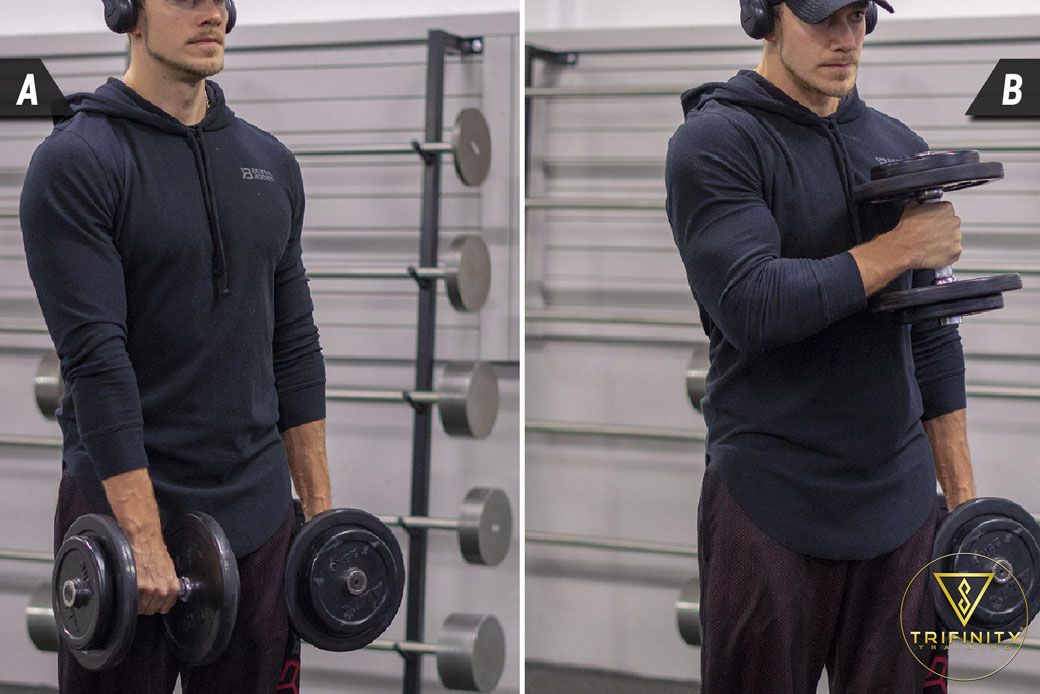
3. Biceps curls in cable machine with straight bar or Z-grip
To get some variation to the free weights, we finish with biceps curls in a cable machine with a supinated grip. Focus on the full range of motion and to really feel the muscle you are working out.
Set 1: 8-12 reps, with 3-4 sec eccentric phase (down) on each rep
Set 2: 8-12 reps, with 3-4 sec eccentric phase (down) on each rep
Set 3: 8-12 regular reps and drop the weight once (put a lower weight and do another set without extra rest in between) and aim for 10+ reps here.
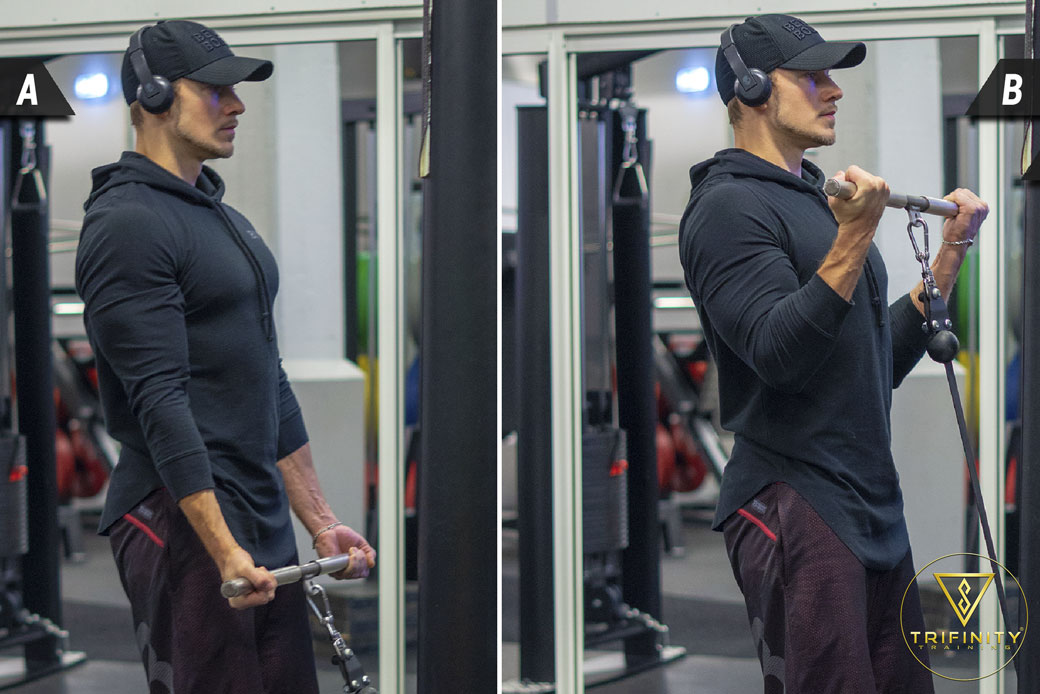
There you go! That is it! These exercises above will activate all the parts of your biceps we have gone through now and provide a stimulus for growth. I’m starting to feel like I’ve done mine now and it’s up to you to take this from here and go lift the weights. If you have questions, thoughts or ideas I look forward to hearing from you. You can do this in the contact form that you find by clicking here or by clicking on the chat icon at the bottom right.
Good luck with your biceps workout! Train hard – but smart.
You will hear from me again at part 2 where we dive into the other arm muscle triceps.
